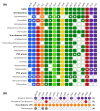Was the Last Bacterial Common Ancestor a Monoderm after All?
- PMID: 35205421
- PMCID: PMC8871954
- DOI: 10.3390/genes13020376
Was the Last Bacterial Common Ancestor a Monoderm after All?
Abstract
The very nature of the last bacterial common ancestor (LBCA), in particular the characteristics of its cell wall, is a critical issue to understand the evolution of life on earth. Although knowledge of the relationships between bacterial phyla has made progress with the advent of phylogenomics, many questions remain, including on the appearance or disappearance of the outer membrane of diderm bacteria (also called Gram-negative bacteria). The phylogenetic transition between monoderm (Gram-positive bacteria) and diderm bacteria, and the associated peptidoglycan expansion or reduction, requires clarification. Herein, using a phylogenomic tree of cultivated and characterized bacteria as an evolutionary framework and a literature review of their cell-wall characteristics, we used Bayesian ancestral state reconstruction to infer the cell-wall architecture of the LBCA. With the same phylogenomic tree, we further revisited the evolution of the division and cell-wall synthesis (dcw) gene cluster using homology- and model-based methods. Finally, extensive similarity searches were carried out to determine the phylogenetic distribution of the genes involved with the biosynthesis of the outer membrane in diderm bacteria. Quite unexpectedly, our analyses suggest that all cultivated and characterized bacteria might have evolved from a common ancestor with a monoderm cell-wall architecture. If true, this would indicate that the appearance of the outer membrane was not a unique event and that selective forces have led to the repeated adoption of such an architecture. Due to the lack of phenotypic information, our methodology cannot be applied to all extant bacteria. Consequently, our conclusion might change once enough information is made available to allow the use of an even more diverse organism selection.
Keywords: Bayesian inference (BI); ancestral traits; bacterial evolution; cell-wall; comparative genomics; outer membrane (OM); phylogenomics.
Conflict of interest statement
The authors declare no conflict of interest.
Figures



References
-
- Coico R. Gram Staining. Curr. Protoc. Microbiol. 2006:A-3C. - PubMed
Publication types
MeSH terms
LinkOut - more resources
Full Text Sources

